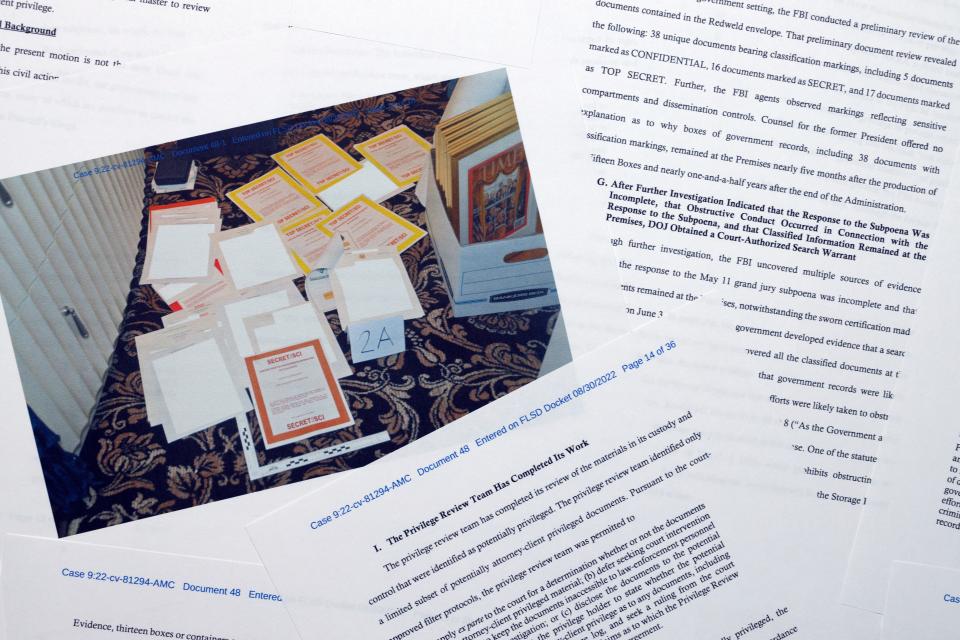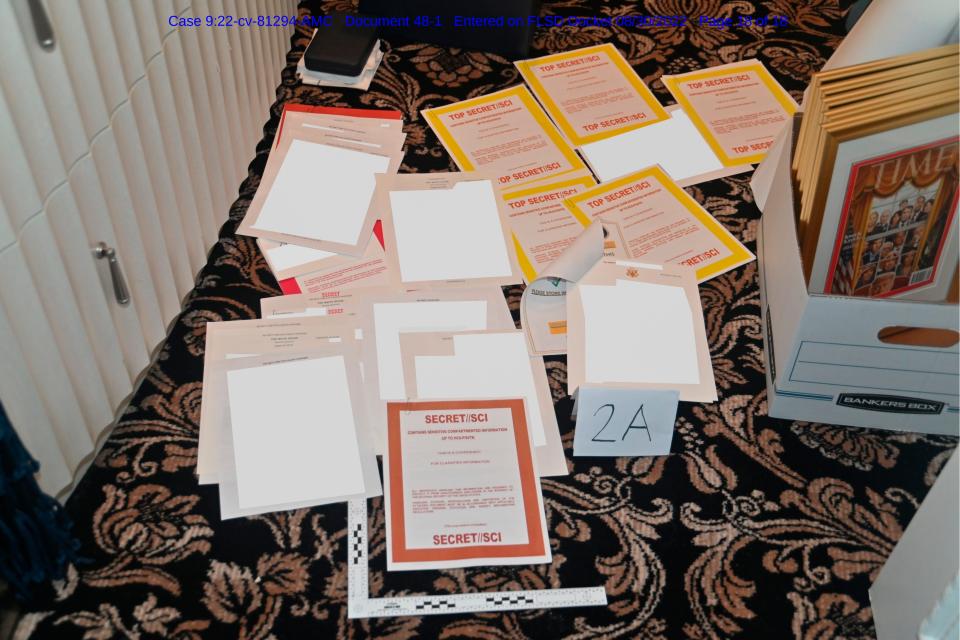DOJ mapped out strong obstruction evidence against Trump, aides in filing, experts say
- Oops!Something went wrong.Please try again later.
WASHINGTON – A Justice Department court filing elaborating on the search of Donald Trump’s Florida estate explains in the strongest terms yet – short of actually filing charges – a potential case for obstruction of justice against the former president and his aides, according to legal experts.
The extraordinary filing, a response to the former president's request for a third-party special master to oversee the review of seized records, accused Trump’s team of concealing and moving documents in an effort to impede the investigation, possibly implicating them in a scheme to shield hundreds of classified documents from investigators for a year and half after he left office.
"Donald Trump has drawn a bullseye on himself," said David Weinstein, a former Florida federal prosecutor, referring to a striking photograph included in the government's filing which showed clearly marked classified documents strewn across the floor of Trump's office next to a box of what appears to be Time magazine covers.
DOJ says documents likely hidden at Trump's estate: DOJ says it’s ‘likely’ Mar-a-Lago documents were hidden and efforts made to obstruct probe
"This is not a pretty picture for anybody; you're not only talking about obstruction but you are co-mingling classified information with other materials outside a secure facility in violation of the Espionage Act," Weinstein told USA TODAY. "The former president and his legal team need to be very concerned."
The Aug. 8 search warrant sought evidence for potential violations of three statutes: the Espionage Act, mishandling national defense documents and obstruction of justice. The obstruction charge is more serious, carrying a maximum 20-year prison sentence, than the Espionage Act's maximum 10-year sentence.
“You’ve got a pretty compelling cumulative picture now which suggests obstruction of justice, which is nothing more than trying to influence, obstruct or impede a judicial proceeding that has to be done corruptly," Kevin O'Brien, a former federal prosecutor now at Ford O'Brien Landy LLP, told USA TODAY. “He’s in a heap of trouble, I think."
Ryan Goodman, a former special counsel to the general counsel at the Defense Department and now a law professor at New York University, said a key element for proving obstruction would be the false statement June 3 from a Trump aide that all classified documents had been returned to the government.
Who is Trump lawyer Christina Bobb?: How Trump lawyer Christina Bobb, an ex-OAN host, took spotlight in Mar-a-Lago case
Prosecutors would need to prove beyond a reasonable doubt that lawyers knew the statement was false or that Trump knowingly gave them false information, but witnesses and surveillance tapes could prove that case, Goodman said.
“If it can be proven that Trump directed or otherwise ensured that documents with classified markings be kept from the DOJ following the subpoena it would likely be an open and shut case under all of the charges cited in the arrest warrant,” Goodman told USA TODAY.

The Justice Department filing opposed a Trump lawsuit asking for a special master to review the documents seized during the Aug. 8 search. U.S. District Judge Aileen Cannon scheduled a hearing Thursday about whether to appoint a special master, which the Justice Department said was unnecessary.
The filing described how Trump kept a trove of documents including hundreds of classified records at Mar-a-Lago for a year and a half after his administration ended, in violation of federal law.
University of Richmond law professor Carl Tobias said the filing “carefully and comprehensively makes out the case for obstruction and shows the great lengths to which the government went to retrieve the documents, because of their importance, for example, to national security and national defense.”
“DOJ has succeeded in threading the needle by employing its legal filing to refute the claims by Trump and his counsel and supporters that all documents were returned or recovery of the documents was not necessary,” Tobias told USA TODAY. “DOJ also shows that the court lacks jurisdiction to hear Trump’s special master request, Trump lacks standing to pursue relief, and the request is moot” since federal officials have already reviewed the documents, removing the need for a special master.
Top secret documents were uncovered in January, then more in June and more in August
Trump gave the National Archives and Records Administration 15 boxes of documents in January, including 92 "secret" documents and 25 "top secret" documents totaling 700 pages. Some of the documents were among the most sensitive the government has, for dissemination through compartments used to restrict access for national security.
When three FBI agents and a Justice Department lawyer visited Mar-a-Lago on June 3 with a subpoena for documents, they retrieved 16 "secret" documents and 17 "top secret" documents. The classified documents were handed over in a single Redweld envelope, double-wrapped in tape, according to the filing.
But Trump’s lawyers who were present during the visit, prevented federal authorities from looking in other boxes in the storage room, where the lawyers said all classified documents were stored, according to court records.
"Critically, however, the former President's counsel explicitly prohibited government personnel from opening or looking inside any of the boxes that remained in the storage room, giving no opportunity for the government to confirm that no documents with classification markings remained," the Justice Department filing said.
A Trump lawyer, whom the New York Times identified as Christina Bobb, signed a sworn certification June 3 stating “a diligent search was conducted” for documents sought under the subpoena and “any and all documents” were returned to the government under the subpoena.
David Laufman, a former CIA analyst and federal prosecutor now at Wiggin and Dana LLP, said the certification portrayed the assurance from Trump that all classified documents had been returned by June 3, leaving him and his lawyers in potential legal jeopardy.
“That is clearly, egregiously, demonstrably false," Laufman told USA TODAY. “These are pretty damning pieces of information."
More: Trump records investigation: From early red flags to the search at Mar-a-Lago
But the FBI “uncovered multiple sources of evidence” indicating more documents remained at Mar-a-Lago, according to the filing. The investigation involved “a significant number of civilian witnesses,” according to the FBI agent affidavit justifying the search Aug. 8.
O'Brien said he wasn't sure what Trump's defense might be, but that he could potentially blame his lawyers.
"But that only gets him so far," O'Brien said. "That doesn’t explain why there are top secret highly sensitive documents in his office, in his desk."
The August search recovered 76 documents with classification markings from the storage room and found others elsewhere in the compound, including three classified records in the desk in Trump’s office.
“The government developed evidence that a search limited to the Storage Room would not have uncovered all the classified documents at the Premises,” the Justice Department filing said. “The government also developed evidence that government records were likely concealed and removed from the Storage Room and that efforts were likely taken to obstruct the government’s investigation.”

An FBI photo taken in the “45 Office” shows documents stamped HCS-HUMINT Control System, which designates highly sensitive records about clandestine human sources.
“The materials have quite clearly on their face all those acronyms that suggest this is human intelligence, meaning real people in the field are feeding this information to the CIA and other government agencies, which puts their lives in danger if this kind of material ever gets out into the wrong hands," O'Brien said.
The Justice Department argued they found classified documents in hours that Trump's team had failed to turn over for months.
“That the FBI, in a matter of hours, recovered twice as many documents with classification markings as the ‘diligent search’ that the former President’s counsel and other representatives had weeks to perform calls into serious question the representations made in the June 3 certification and casts doubt on the extent of cooperation in this matter.”
Trump hasn't offered a substantive reason why he kept the documents. But he blasted the search as a partisan investigation and claimed without documentation to have declassified the records. The potential federal charges governing administration documents don't require the records to be classified.
"Terrible the way the FBI, during the Raid of Mar-a-Lago, threw documents haphazardly all over the floor (perhaps pretending it was me that did it!), and then started taking pictures of them for the public to see," Trump said Wednesday in a post on Truth Social. "Thought they wanted them kept Secret? Lucky I Declassified!"
Jonathan Turley, a law professor at George Washington University who has spoken repeatedly in defense of Trump, suggested keeping the documents at Mar-a-Lago could have been a mistake.
“It is not clear from the filing if the FBI has evidence of intentional acts of concealment as opposed to negligence in keeping track of such material,” Turley wrote in his blog.
But O'Brien said it was clearly not a mistake after months of warnings.
“It’s not a mistake, they lied," O'Brien said. "I don’t think that explanation is going to hold up at all."
Andrew Weissmann, the lead prosecutor in special counsel Robert Mueller’s investigation of Russian interference in the 2016 election and now a law professor at New York University, said the filing indicated prosecutors intend to seek an indictment.
“DOJ BIG PICTURE: you don’t make a filing this strong, bold, and factually accusatory if you don’t have every intention to indict,” Weissmann said in a tweet.
Bradley Moss, a national-security lawyer, said the filing shows Trump took plainly marked classified documents to Mar-a-Lago and then he or his staff concealed the records from investigators.
“That is straight up obstruction and concealment of classified records, and willfully retaining them in an unauthorized fashion,” Moss said in a tweet.
This article originally appeared on USA TODAY: Trump Mar-a-Lago documents: DOJ mapped out obstruction case: experts

